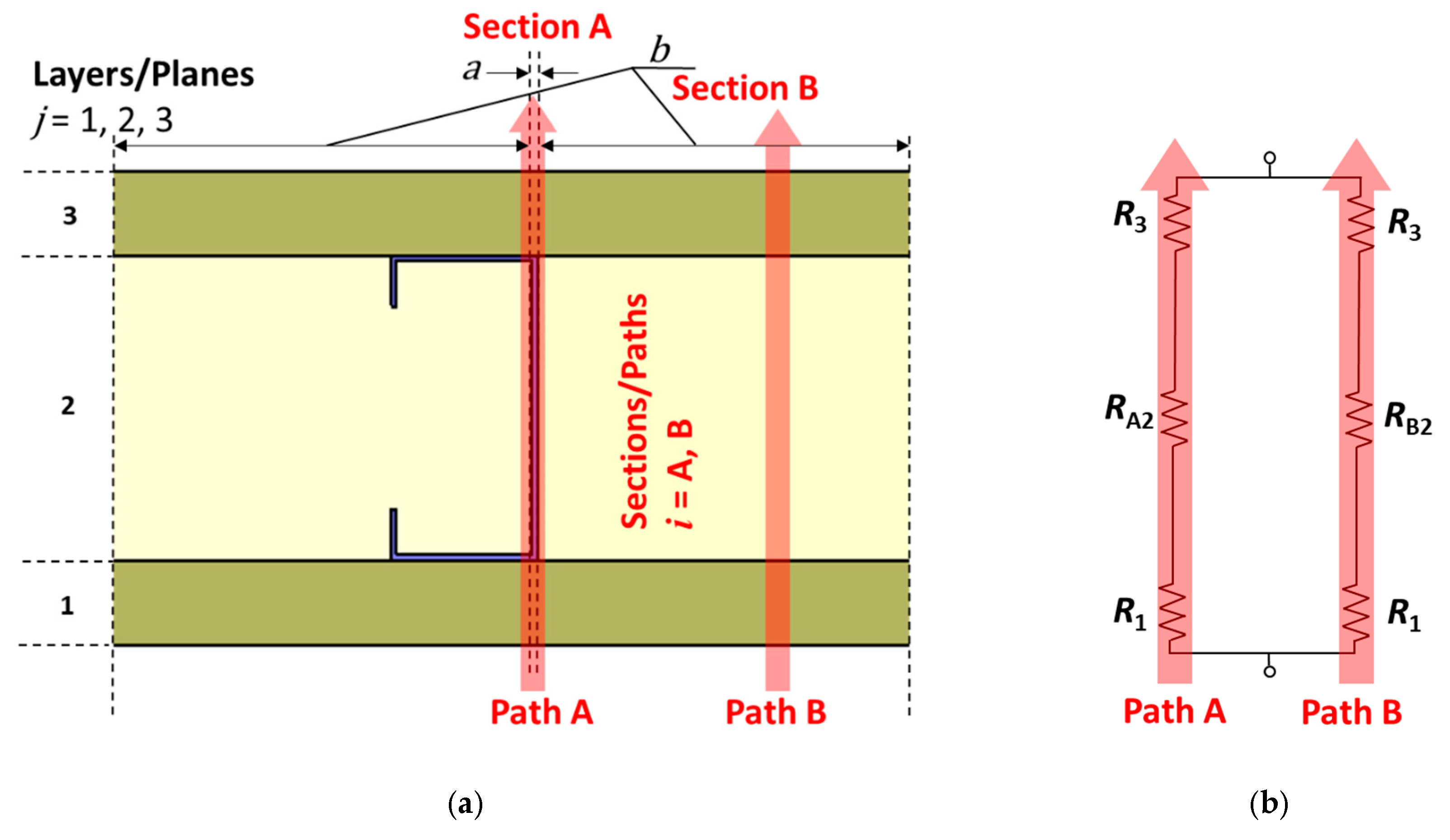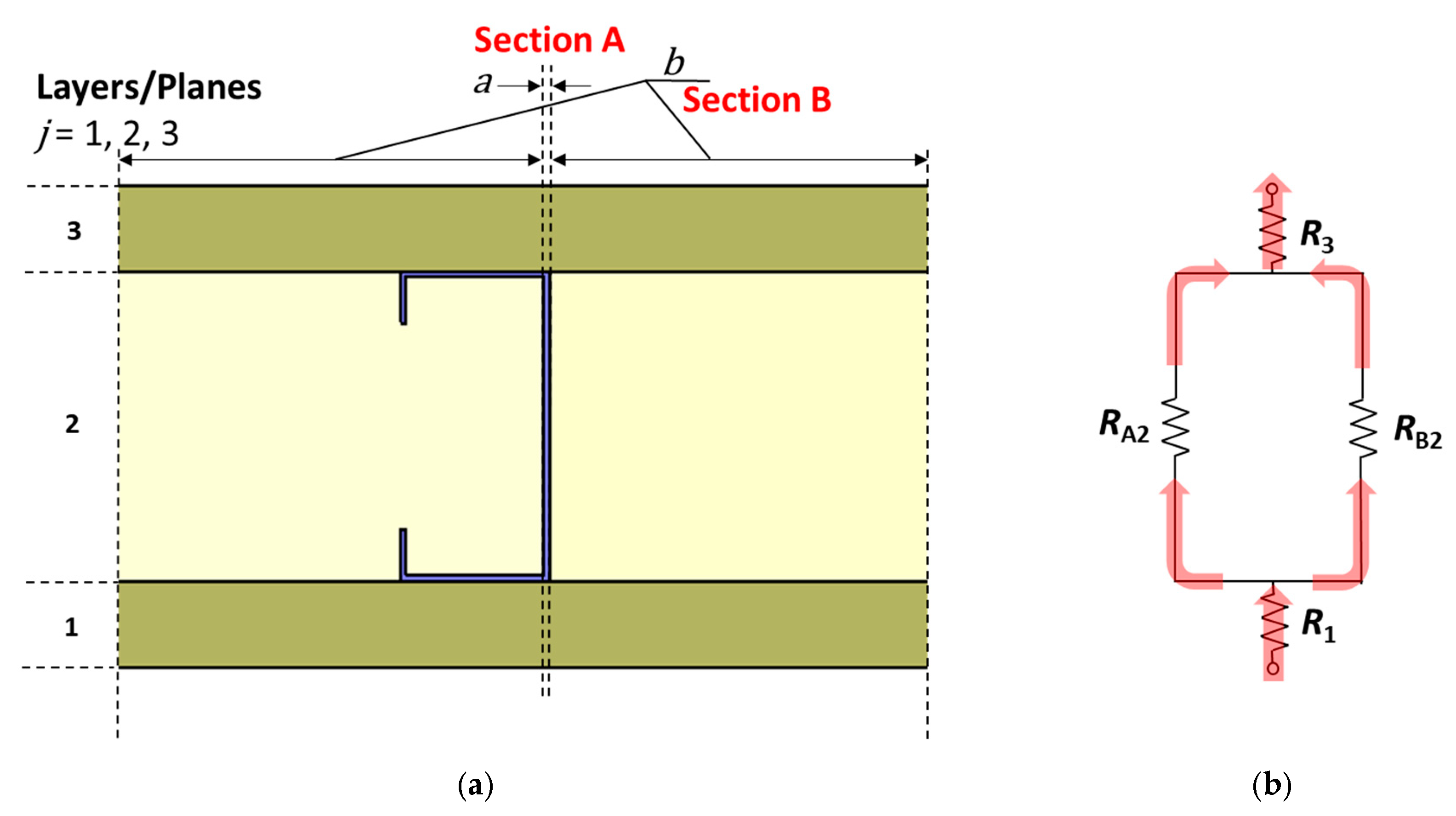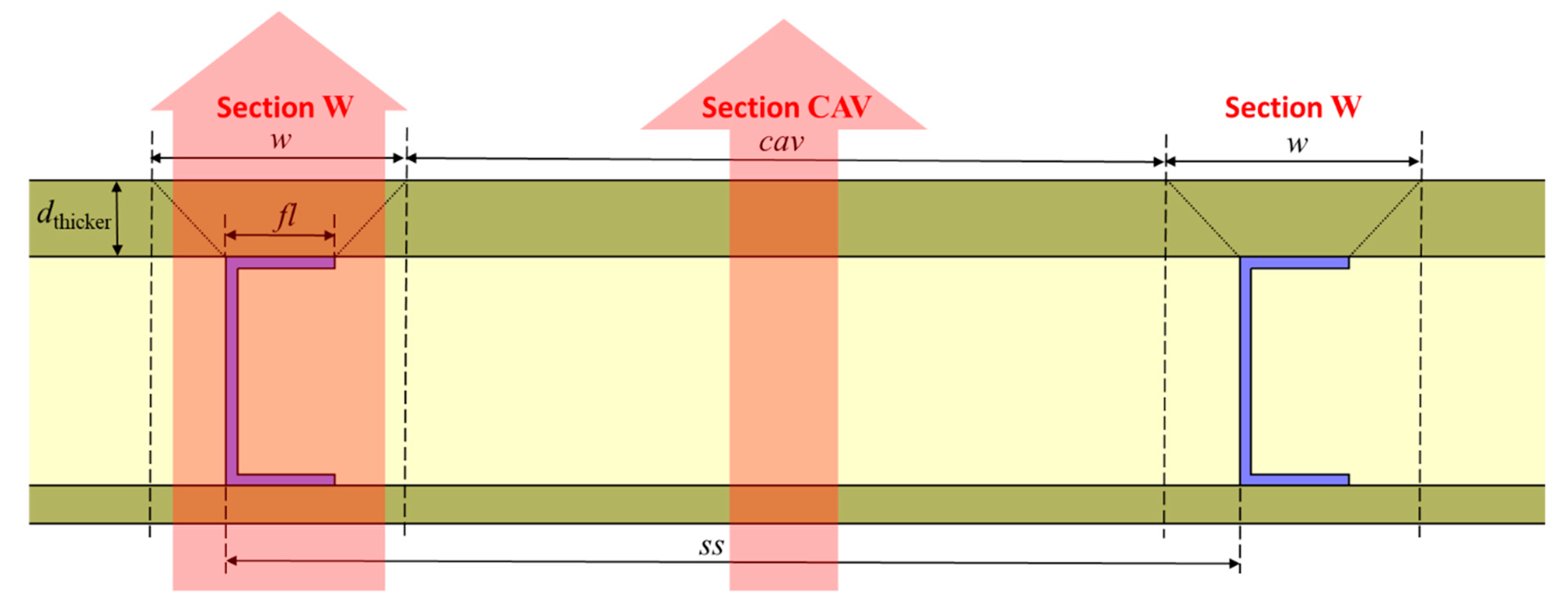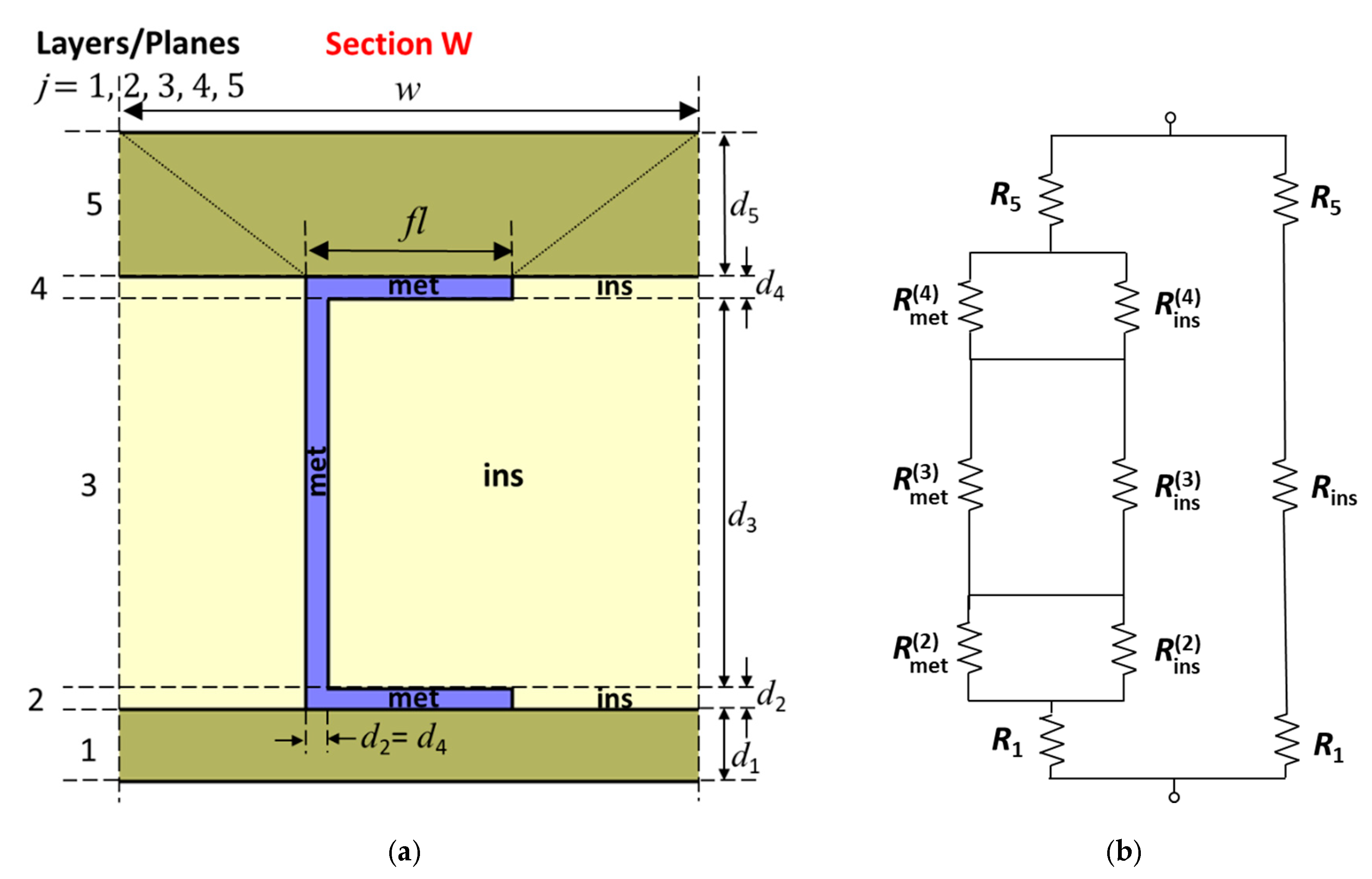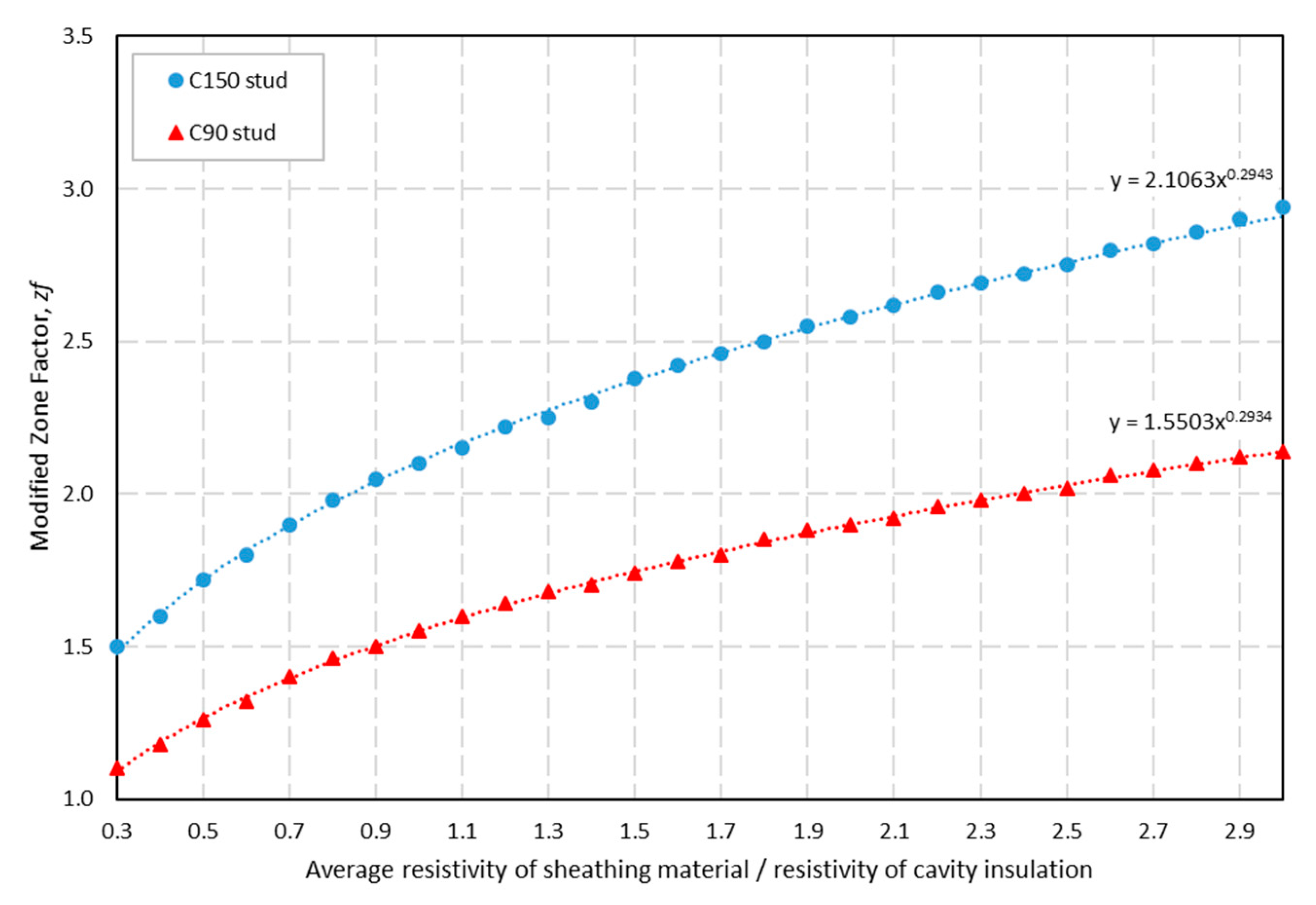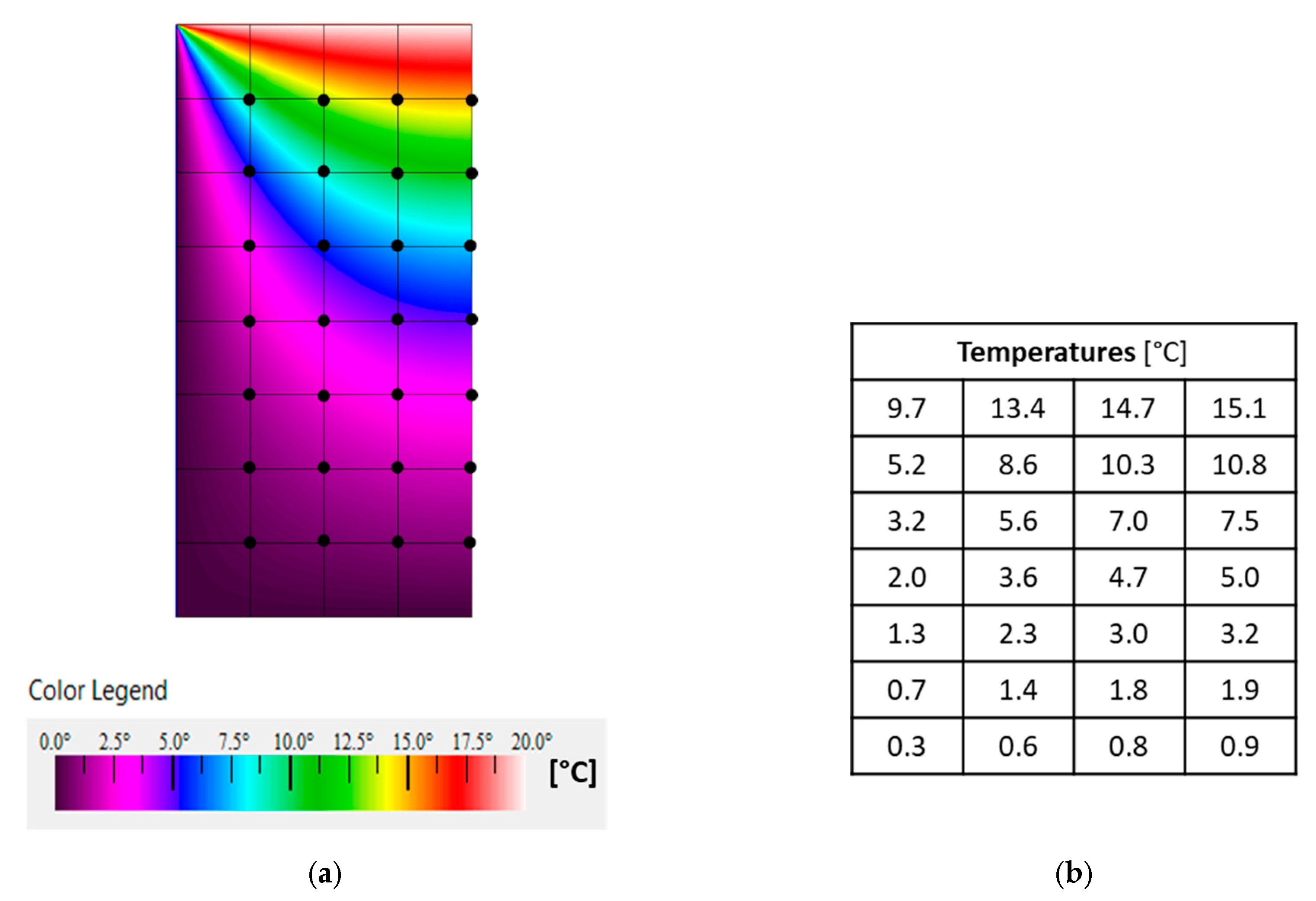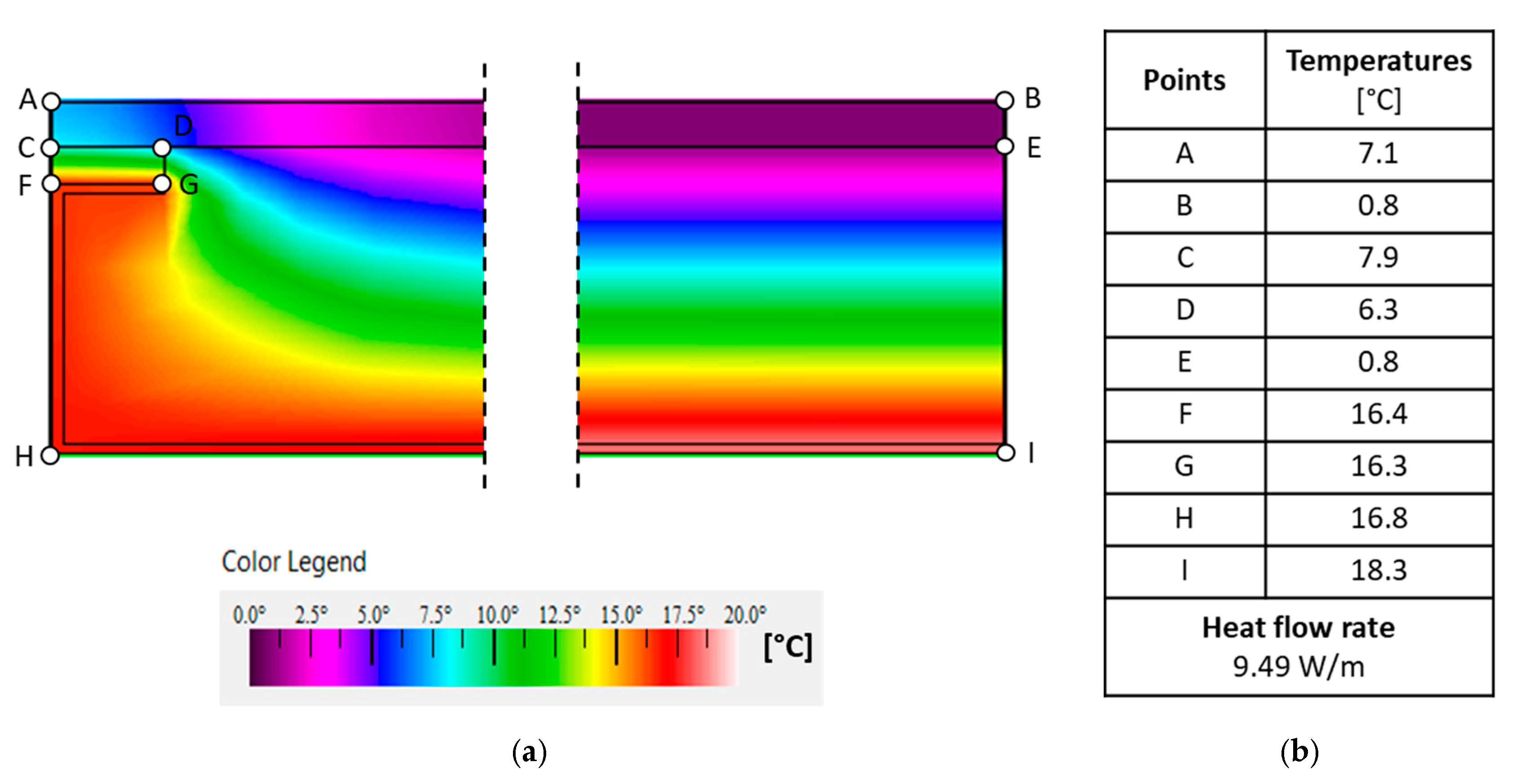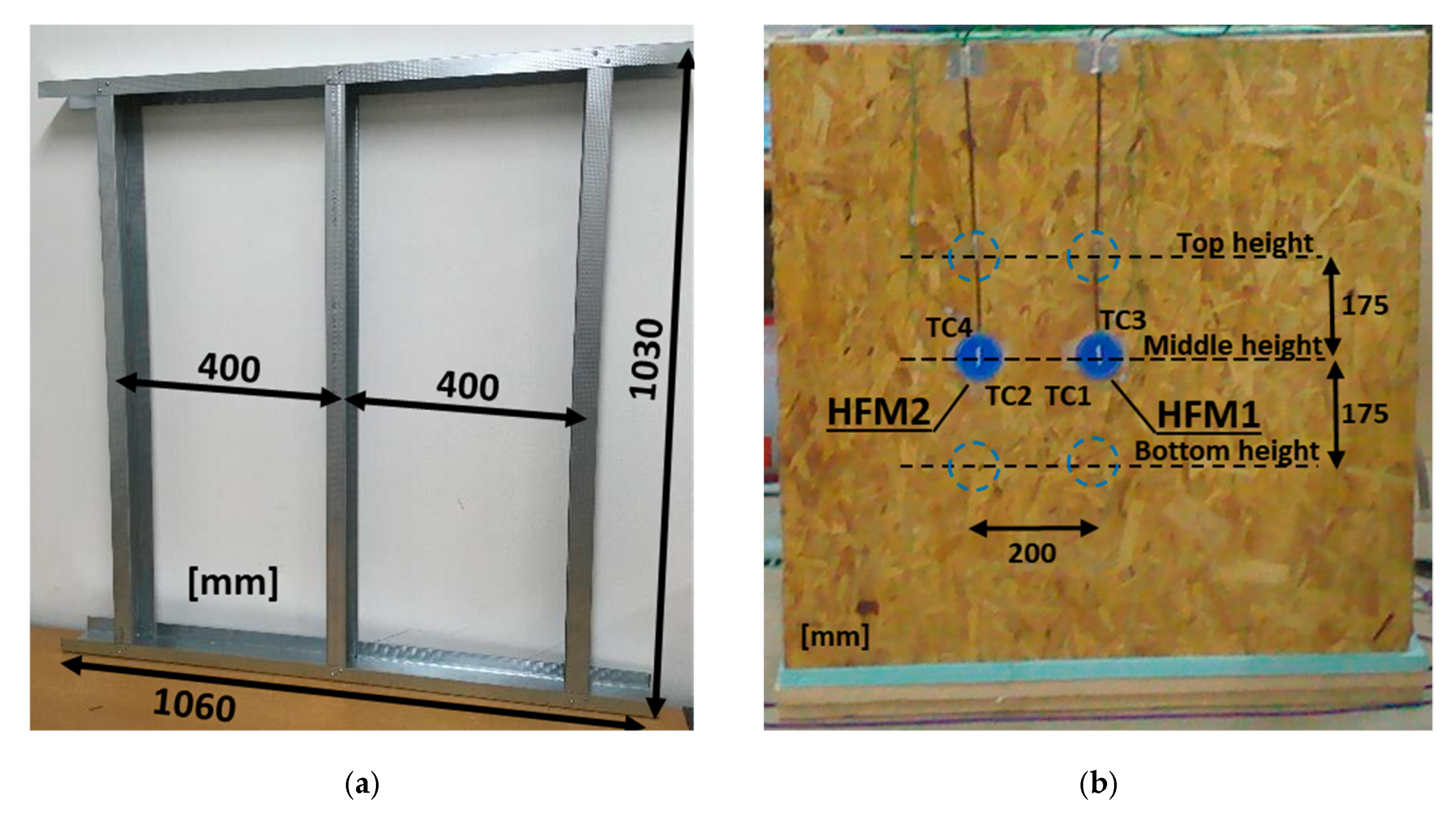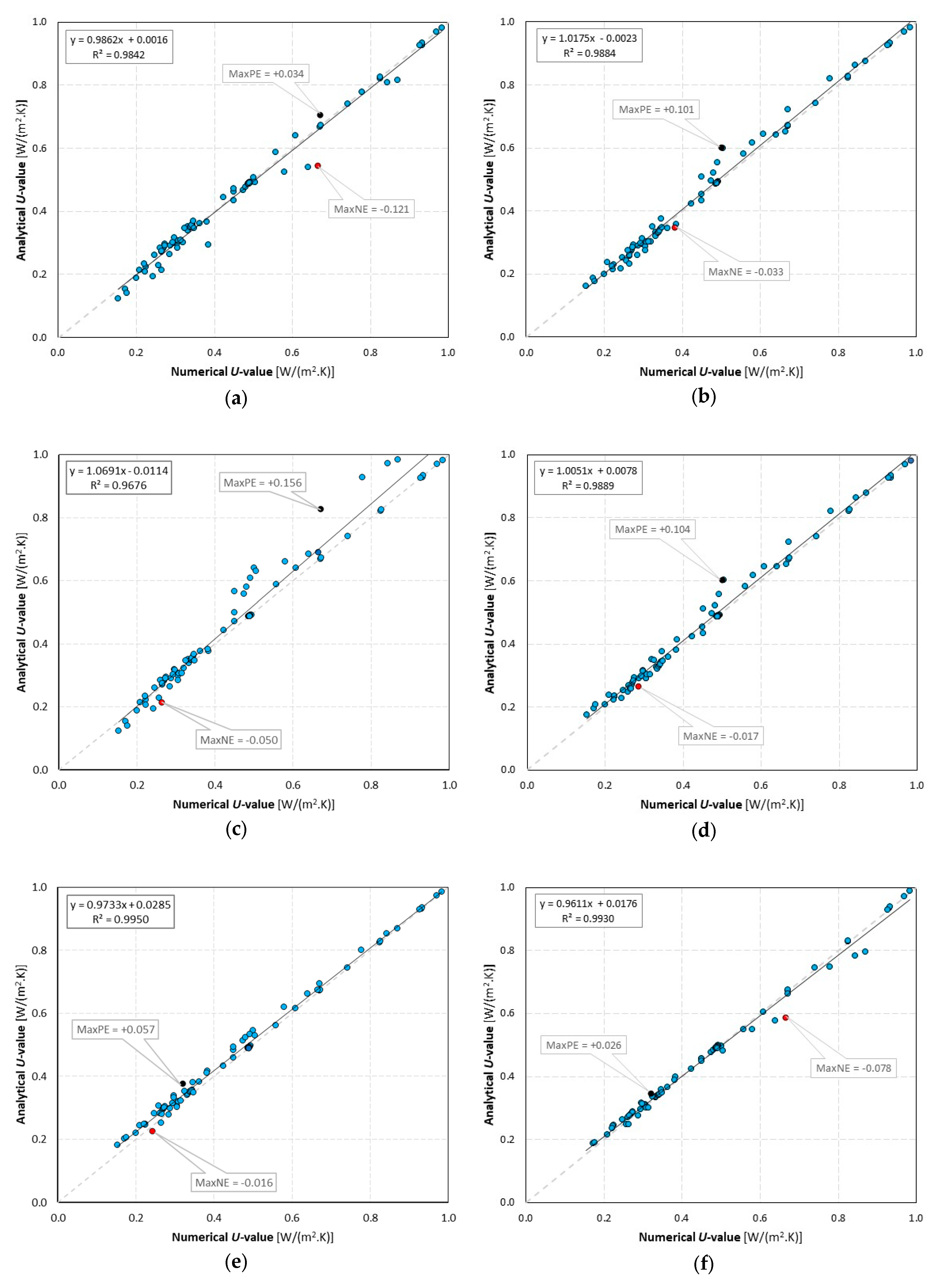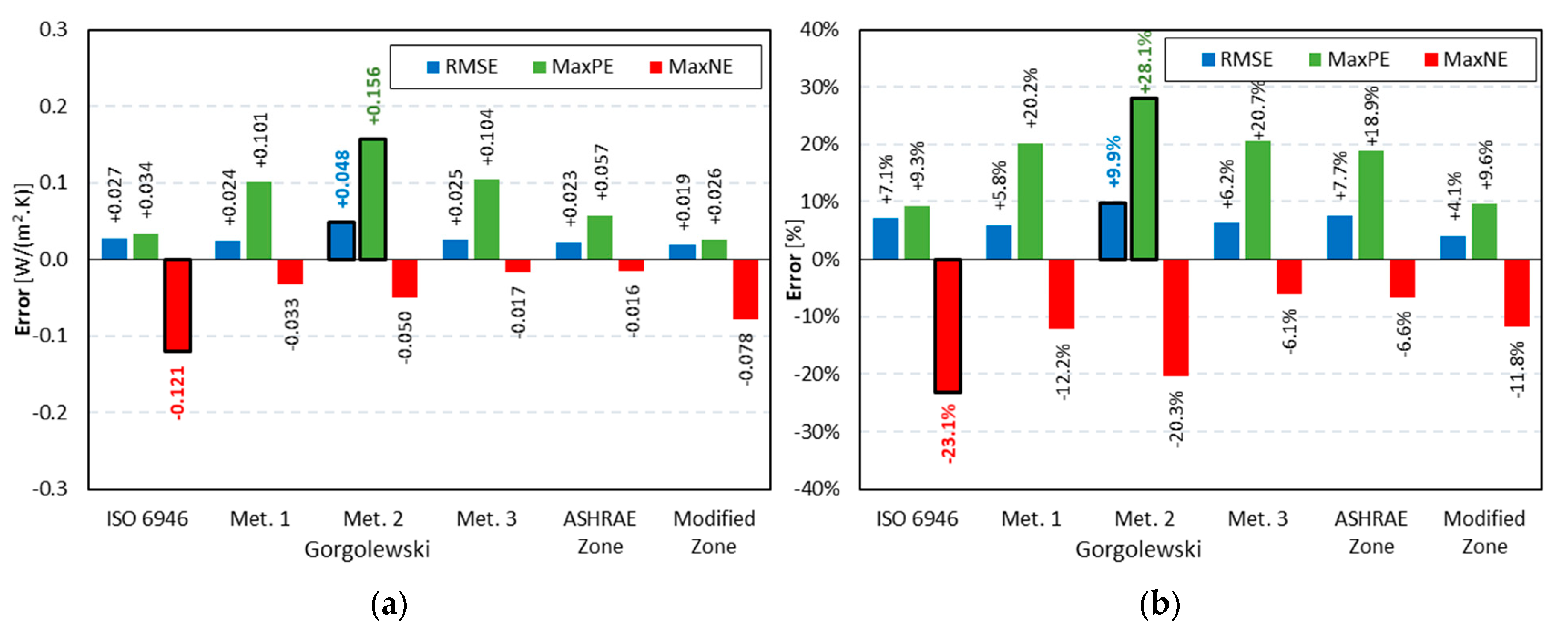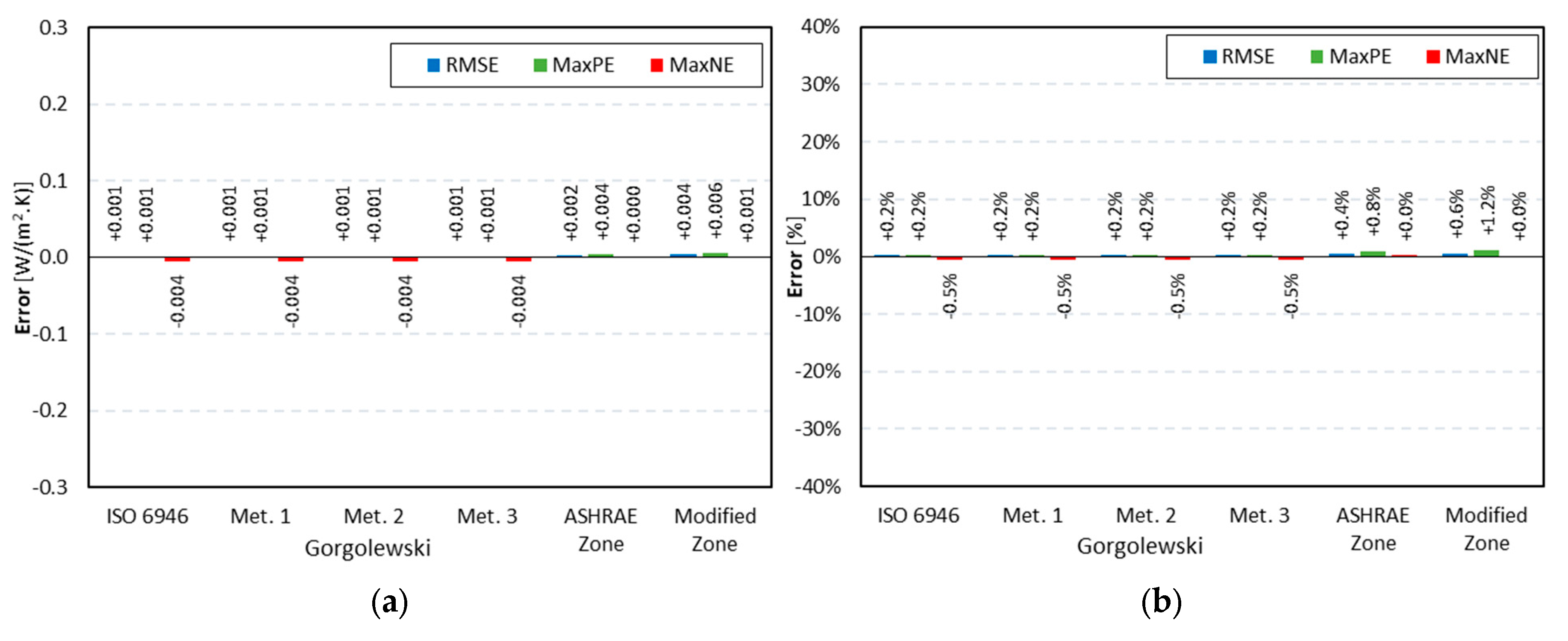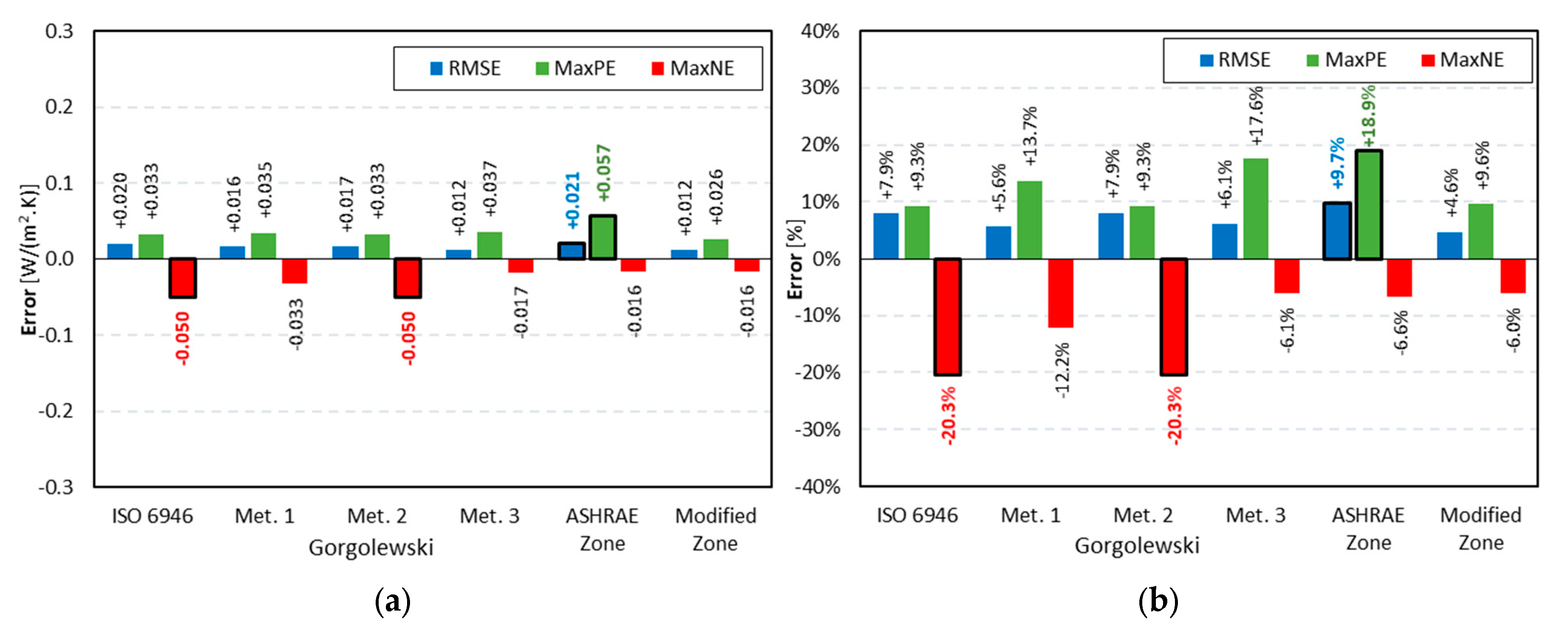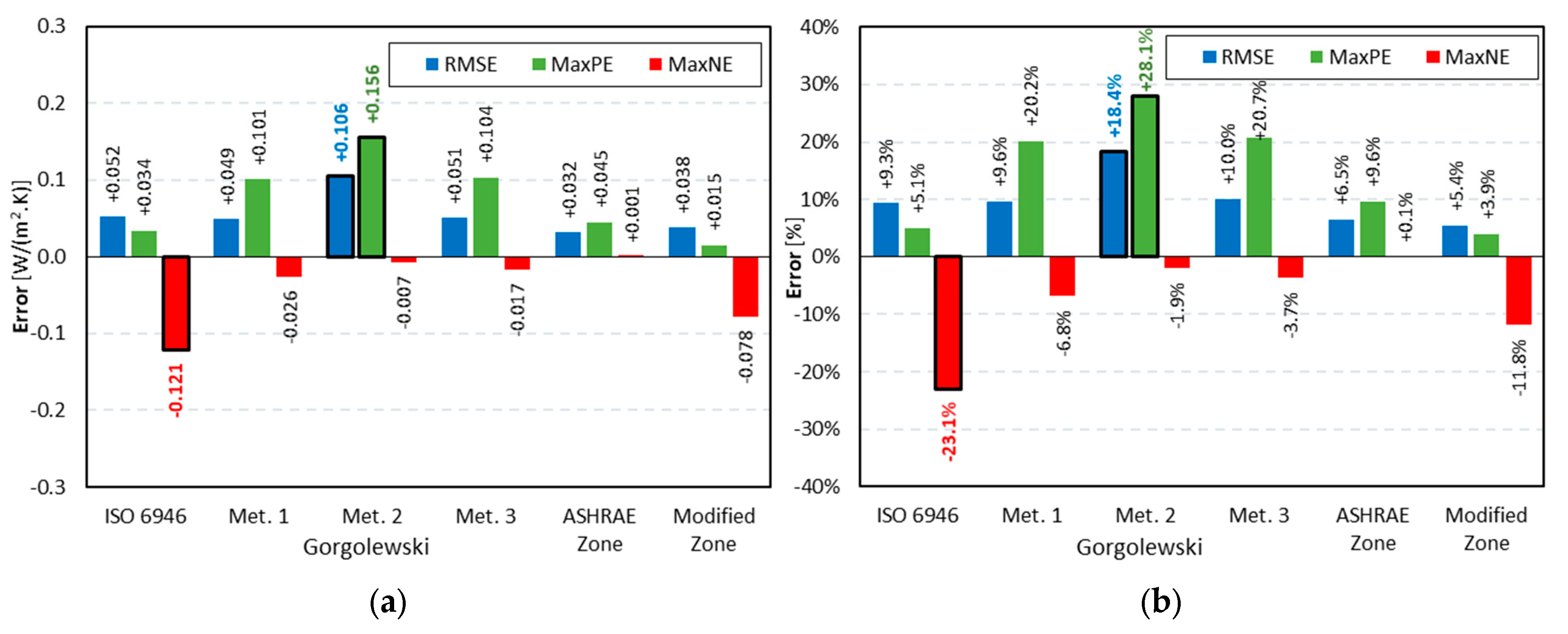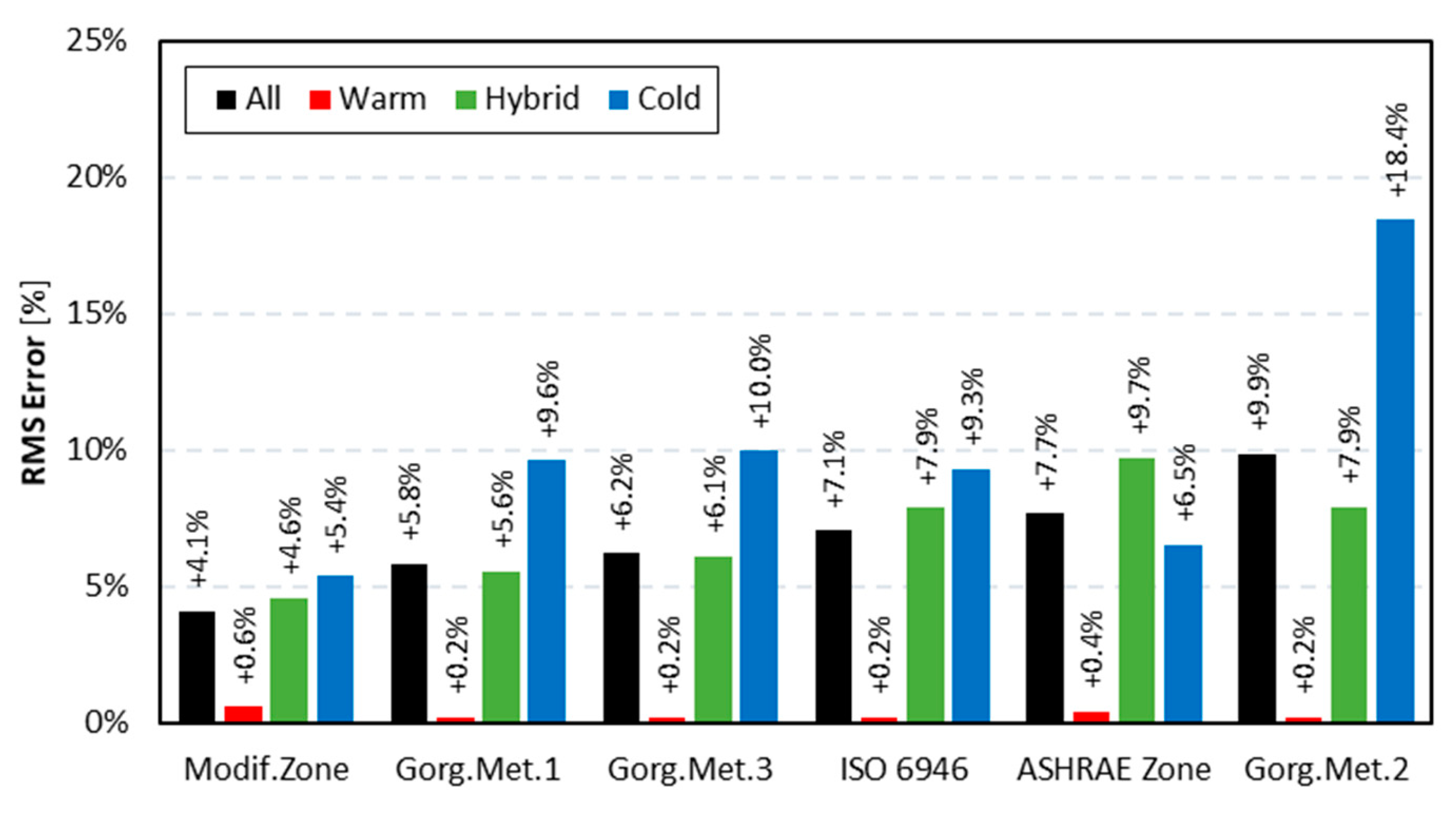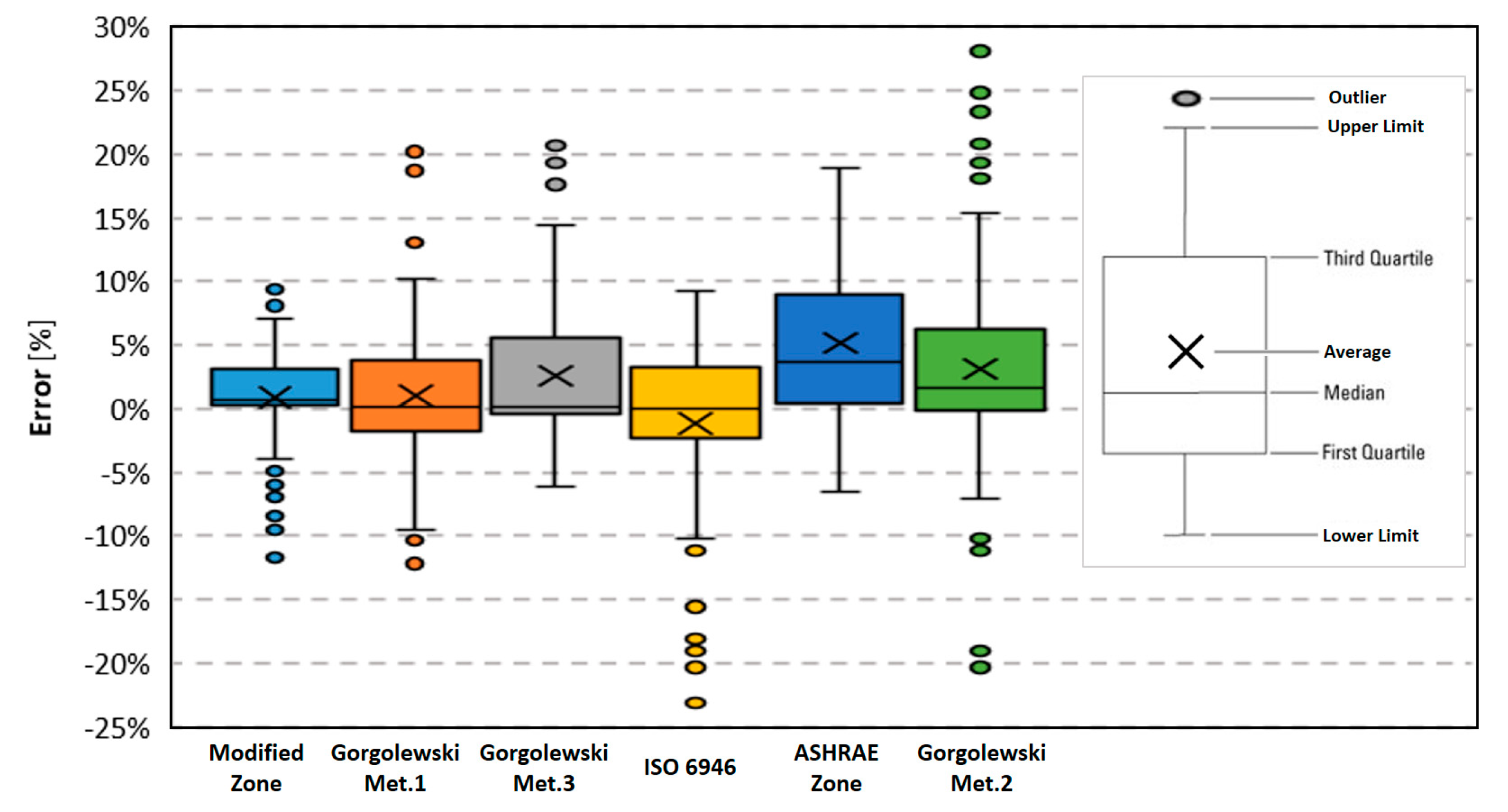1. Introduction
The use of lightweight steel frame (LSF) systems has emerged as a viable alternative to traditional construction and its usage are increasing every year, mostly because of its great advantages, such as: cost efficiency, reduced weight, mechanical resistance, fast assemblage and others [
1,
2]. However, the high thermal conductivity of the steel could lead to thermal bridges effects resulting in a poor thermal performance of the building if those issues are not properly addressed (e.g., at design stage) [
3].
A usual LSF wall is mainly composed of three parts: (1) steel frame internal structure (cold formed profiles); (2) sheathing panels (internal and external, e.g., gypsum plasterboard and OSB); (3) the insulation layers (cavity/batt insulation, such as mineral wool, and/or ETICS-exterior thermal insulation composite system) [
3]. Notice that the batt insulation, besides the thermal insulation function, can also perform an important acoustic insulation function [
4]. Moreover, the effectiveness of thermal insulation depends on its position in the LSF element [
5], as well as on the type of LSF construction [
6].
In fact, the existence of an insulation layer and its position on the wall determines the type of LSF construction. According to Santos et al. [
1], a LSF construction element can be classified into three wall frame typologies: (1) cold, (2) hybrid, and (3) warm. On cold frame constructions, all the thermal insulation is placed inside the wall air cavity, between the vertical studs and limited to the stud depth. The opposite happens with the warm frame construction, where all thermal insulation is continuous and located outside of the steel frame (ETICS). Given its advantages, the hybrid construction type is used more often [
4], being an intermediate solution between cold and warm construction and has both types of insulation applied: continuous exterior (ETICS) and between the steel studs (cavity insulation).
An accurate evaluation of the thermal transmittance (
-value) of building envelope elements is fundamental for a reliable assessment of their thermal behaviour and energy efficiency [
7]. LSF elements are even more challenging given the very reduced thickness of the cold formed steel profiles and the strong contrast between its thermal properties (e.g., thermal conductivity) and the thermal insulation materials (e.g., mineral wool) [
8]. In buildings, despite thermal bridges originated by the high thermal conductivity of the steel frame [
9], it is needed to account for flanking thermal losses around and in the intersection of building LSF components [
10].
There are several approaches to obtain the thermal resistance/transmittance of building elements: (i) analytical, (ii) numerical, and (iii) measurements [
11]. Regarding thermal performance measurements, they could be accomplished in-situ or in laboratory settings, being crucial for the validation of numerical and analytical methods [
7]. In-situ non-destructive thermal transmittance measurements in existing buildings are very important for energy audit and retrofitting actions [
7], which is very challenging to perform since the properties of materials are often unknown, components frequently degrade over time, and the experiments should be fast, simple and non-destructive [
12]. Measurements under laboratory conditions have the advantages of well-known controlled environmental conditions, geometries, configurations and materials [
7], but could be very time-consuming and expensive. There are various measurement methods, the most used ones being [
7]: the heat flow meter (HFM) [
13]; the guarded hot plate (GHP) [
14]; the hot box (HB) [
15], which could be calibrated (CHB) [
16] or guarded (GHB) [
17]; infrared thermography (IRT) [
18].
Numerical simulations could be performed with more simpler two-dimensional (2D) models [
5,
6] or more complex/detailed three-dimensional (3D) models [
9,
10]. They have the advantage of allowing a quick comparison between several building component solutions/configurations. However, they need a specific software tool, skills to use it and to ensure the reliability of the obtained results the used models should be validated with measurements or at least verified by comparison with benchmark results.
The use of analytical formulas could be the simplest approach of all these three methods, being very useful and easy to use by designers [
8]. However, this analytical approach is usually only available for simpler configurations; its applicability being, most often, very limited. Moreover, these analytical calculation formulations frequently consider a simplified steady-state one-dimensional (1D) heat transfer and do not take into account the heat storage inside the material, nor the thermal properties variation (e.g., with temperature or humidity) [
19].
The use of analytical methods to calculate the thermal resistance (
-value) and transmittance (
-value) of a building element could be a complicated subject, especially when the element has inhomogeneous layers with very dissimilar thermal properties. For LSF constructions, those analytical calculations can be harder than in other forms of construction, as the methodology must include the effects of the non-homogeneous layers, the thermal bridges and the large difference between materials thermal conductivities [
8].
One of the most used simplified analytical methods to calculate the thermal resistance and transmittance of a building component containing homogeneous and inhomogeneous layers is prescribed by standard ISO 6946 [
20]. The total thermal resistance of a component is computed by combining its upper and lower limits, and thus this methodology is often designated as the ISO 6946 Combined Method. These
-value limits are computed making use of the parallel path method (upper limit) and the isothermal planes method (lower limit). The total
-value of the building element is calculated as the average of the upper and lower limits, as previously mentioned. However, this simplified analytical
-value calculation methodology should not be applicable to building elements where the insulation is bridged by metal [
20], as happens in cold and hybrid LSF elements.
This applicability limitation of the ISO 6946 Combined Method has motivated several researchers to seek for a specific analytical methodology suitable to calculate the
- and
-values for LSF building elements. The ASHRAE Zone Method [
19] was one of the first analytical simplified methods to be developed to calculate the
-value of a LSF element. The ASHRAE zone method is a modification of the parallel path method [
21], where instead of considering only the thickness of the steel stud web, it considers a larger zone of influence of the metal thermal bridge within the LSF wall. The width of the area affected by the steel thermal bridge depends on the length of the steel stud flange and on the distance from this metal flange to the wall surface, i.e., the sheathing layers thickness [
21].
Given the reported unsatisfactory accuracy of the ASHRAE Zone Method, Kosny et al. [
21,
22] developed a new improved methodology, often designated as Modified Zone Method [
19]. This enhanced method to estimate the
-value of metal frame walls was developed based on computer-simulation results and experimental measurements of different LSF wall configurations, taking into account several wall parameters, such as stud spacing, stud (depth) and flange sizes, stud metal thickness, the thermal resistance of the cavity insulation and thermal resistance of exterior sheathing [
22]. It was concluded that the differences in the thermal calculations are caused by the metal stud zone area estimation. Thus, a more precise estimation technique to define the thermally affected zones caused by steel studs of LSF walls was developed and implemented.
More recently, Gorgolewski [
8] adapted the ISO 6946 Combined Method to a more accurate analytical
-value calculation methodology for LSF building components, including cold and hybrid frames. In this new suggested analytical methodology, the upper and lower
-values limits are still being used, but instead of an average between these limits Gorgolewski found an “algorithm” for estimating the adequate weighting between them [
8]. It was proposed and compared the accuracy of three analytical methods, being taken into account some parameters of the steel frame elements, such as flange width, stud spacing and stud depth. The third method developed by Gorgolewski was found to exhibit the best accuracy performance and thus it was adopted in the United Kingdom for LSF buildings code of practice [
23].
As reviewed before, there are several analytical simplified methods available in the literature to compute the thermal resistance or transmittance of LSF building elements. However, it was not found in the bibliography any research work with the evaluation and comparison of the accuracy performance of these different analytical methodologies. Moreover, ISO 6946 [
20] states that the prescribed Combined Method is not suitable to estimate the
-value of cold and hybrid LSF elements, but it is not known how large is this methodology calculation error.
In this context, the main aim of this work—besides to perform a review of the analytical methods calculation procedures—is to evaluate and compare the accuracy of the above mentioned simplified analytical methods. With this goal, six analytical methods were used to estimate the thermal transmittance values of eighty different LSF walls. The obtained analytical
-values were compared with those provided by numerical simulations, which were used as reference
-values. The numerical simulations were performed using a 2D steady-state finite element method (FEM) based software, THERM [
24]. The reliability of these numerical models was ensured via comparison with benchmark values. Additionally, an experimental validation of some LSF numerical models was also accomplished.
This paper is structured as follows. After this introduction, the six evaluated analytical methods are described, namely the ISO 6946 Combined Method, the three Gorgolewski methods and the two ASHRAE methods (zone and modified zone). Next, the numerical reference FEM models are described, including the benchmark verification and experimental validation, the boundary conditions used and the air-layer modelling. Subsequently, all the assessed 80 LSF walls are described, including the parameters evaluated, the variables changed and the values considered in the assessment; then we present the dimensions and thermal properties of the materials used in this study. Afterwards, the obtained results are presented and discussed. Finally, the main concluding remarks of this work are described.
3. Results and Discussion
3.1. All LSF Walls
The
-values obtained by the six analytical methods for all the evaluated LSF walls are plotted on
Figure 11. Each point in these graphics represents a different LSF wall, being the value on the horizontal axis the reference
-value provided by the numerical 2D FEM simulations, while the value on the vertical axis is the analytical
-value estimated by the respective method: (a) ISO 6946 Combined Method; (b) Gorgolewski Method 1; (c) Gorgolewski Method 2; (d) Gorgolewski Method 3; (e) ASHRAE Zone Method; (f) Modified Zone Method.
Moreover, these plots also display a linear trend-line, the R-squared coefficient of determination, the maximum positive error (MaxPE), as well as the maximum negative error (MaxNE) for each analytical method, as well as a 45 degrees’ inclination line, that corresponds to the plots position for a virtual perfect match between the analytical and the numerical methods.
First of all, it could be concluded that there is a quite good agreement between the -values provided by the analytical methods evaluated and the numerical reference ones, evidencing a pretty good accuracy of these analytical methods.
Gorgolewski Method 2 (
Figure 11c) exhibits a larger dispersion of values mainly for higher
-values (greater than 0.4 W/(m
2·K)). This feature is ensured by the linear trend line, which has the biggest slope (1.0691), being above the 45° diagonal line and—even so—exhibiting the smallest determination coefficient (0.9676). Additionally, a major positive error was also found in this analytical method (+0.156 W/(m
2·K)). This LSF wall is cold framed (without ETICS), having the air cavity 50% filled with mineral wool.
Moreover, the major negative error (−0.121 W/(m
2·K)) was found in the ISO 6946 Combined Method (
Figure 11a). This LSF wall is cold-framed (without ETICS), having GRB sheathing panels. Quite surprisingly, this analytical method provides pretty good accuracy, since according with standard ISO 6946 [
20] it should not be applicable to building elements where the insulation is bridged by metal, as happens in these cold and hybrid LSF walls.
Looking to both ASHRAE methods (
Figure 11e,f), though they have different trends, they both have a very good determination factor (0.995 and 0.993). The ASHRAE Zone Method (
Figure 11e) has a very good precision for higher
-values (e.g., >0.6 W/(m
2·K)), whereas for lower values exhibits a conservative trend, i.e., giving
-values bigger than the real ones. On the other hand, the Modified Zone Method (
Figure 11f) has a good precision for lower
-values (e.g., <0.6 W/(m
2·K)), but for lower values exhibits an overoptimistic trend, i.e.,
-values smaller than the real ones.
Notice that the linear trend-lines presented before and the corresponding determination factors are not the most adequate features to accurately quantify the precision of each analytical method, since they do not correlate the analytical -values with the numerical reference ones, but instead they correlate the analytical values with the corresponding trend-line, which could be very different from the 45° diagonal line.
Thus, it was decided to also compute the root mean square error (RMSE), as an absolute value and as a percentage, which is graphically displayed in
Figure 12. These plots also contain the maximum positive errors (MaxPE) and the maximum negative errors (MaxNE).
The Gorgolewski Method 2 exhibits the major RMS error (+0.048 W/(m2·K); +9.9%), as well as the higher maximum positive error (+0.156 W/(m2·K); +28.1%), confirming the relatively bad accuracy performance of this method. As mentioned before, the maximum negative error was found in the ISO 6946 Combined Method (−0.121 W/(m2·K); −23.1%).
Looking now to the smaller RMS error, the lowest value was found for the Modified Zone Method (+0.019 W/(m2·K); +4.1%). This analytical method also exhibits the lowest absolute MaxPE (+0.026 W/(m2·K)) and the second lowest percentage MaxPE (+9.6%), confirming the relatively good accuracy performance of this method. The lowest absolute negative error was found in the ASHRAE Zone Method (−0.016 W/(m2·K)), while the lowest percentage value was found in the Gorgolewski Method 3 (−6.1%).
Taking into account only the RMSE percentage values, the accuracy performance of these analytical methods could be ranked, from the better to the worst, as follows: (1) Modified Zone Method (+4.1%); (2) Gorgolewski Method 1 (+5.8%); (3) Gorgolewski Method 3 (+6.2%); (4) ISO 6946 Combined Method (+7.1%); (5) ASHRAE Zone Method (+7.7%); (6) Gorgolewski Method 2 (+9.9%).
In the following sections, a similar analysis will be performed, but separating the LSF walls into groups, depending on the frame type: (1) warm; (2) hybrid; (3) cold.
3.2. Warm Frame Walls
Figure 13 shows the absolute and percentage thermal transmittance error values obtained for the warm frame walls. Comparing these values with the previous ones (
Figure 12), the first remarkable feature is that these error values now appear too small. This is justifiable by the existence of only continuous external thermal insulation (ETICS), existing no insulation in the air cavity between the steel studs and therefore without any thermal bridge effect.
The errors are so small in absolute values, ranging between +0.006 W/(m2·K) and −0.004 W/(m2·K), as well as in percentage (+1.2%; −0.5%), that it does not worth it to make a more detailed analysis.
3.3. Hybrid Frame Walls
Figure 14 illustrates the error values obtained for the hybrid frame walls. These error values are considerably higher when compared to the previous warm frame ones (
Figure 13). This is to be expected, as besides the continuous external thermal insulation, there is also batt insulation which is bridged by the steel studs.
In these hybrid frame walls, the major -value RMS error was obtained by the ASHRAE Zone Method (+0.021 W/(m2·K); +9.7%), as well as the higher maximum positive error (+0.057 W/(m2·K); +18.9%), showing a relatively bad accuracy performance of this method. The maximum negative error was achieved by both ISO 6946 Combined Method and Gorgolewski Method 2 (−0.050 W/(m2·K); −20.3%).
The minor -value RMS error was obtained by the Modified Zone Method (+0.012 W/(m2·K); +4.6%), exhibiting also the lowest absolute positive error (+0.026 W/(m2·K)) and the smaller percentage negative error (−6.0%), demonstrating the relatively good accuracy of this analytical method for hybrid frame walls.
Having taken into account only the RMSE percentage values, the accuracy performance of these analytical methods, regarding the computation of hybrid frame walls -values, could be ranked, from the better to the worst, as enumerated next: (1) Modified Zone Method (+4.6%); (2) Gorgolewski Method 1 (+5.6%); (3) Gorgolewski Method 3 (+6.1%); (4) ISO 6946 Combined Method and Gorgolewski Method 2 (+7.9%); (5) ASHRAE Zone Method (+9.7%).
3.4. Cold Frame Walls
The thermal transmittance error values for cold frame walls are displayed in
Figure 15. In general, these error values are even higher than the ones obtained for hybrid fame walls (
Figure 14). These could be explained by the fact that all thermal insulation of the LSF wall is now bridged by the steel studs, exhibiting no continuous external thermal insulation (ETICS).
The major -value RMS error was obtained by the Gorgolewski Method 2 (+0.106 W/(m2·K); +18.4%), as well as the higher maximum positive error (+0.156 W/(m2·K); +28.1%), showing a relatively bad accuracy performance of this method. However, the maximum negative error is the smaller one (−0.007 W/(m2·K); −1.9%). These two facts suggest that this analytical method tends to provide much too conservative -values—i.e., higher than the real ones—originating from a relatively lower precision performance.
The maximum negative error was found in the ISO 6946 Combined Method (−0.121 W/(m
2·K); −23.1%), evidencing that this method could provide significant overoptimistic
-values, i.e., lower than the real ones, being this trend already seen also for hybrid frame walls (
Figure 14).
Observing now the lowest -value RMS errors, the smaller error was obtained by the ASHRAE Zone Method in absolute value (+0.032 W/(m2·K) and by the Modified Zone Method in percentage value (+5.4%). The Modified Zone Method also exhibits the lowest maximum positive error (+0.015 W/(m2·K); +3.9%), revealing also in this parameter a relatively good accuracy performance. Another interesting feature is that all the errors provided by the ASHRAE Zone Method are positive, the minimum value being equal to +0.001 W/(m2·K) and +0.1%, showing a conservative trend.
Taking into account only the RMSE percentage values obtained for the cold frame walls, the accuracy performance of the evaluated analytical methods could be ranked, from best to the worst, as listed next: (1) Modified Zone Method (+5.4%); (2) ASHRAE Zone Method (+6.5%); (3) ISO 6946 Combined Method (+9.3%); (4) Gorgolewski Method 1 (+9.6%); (5) Gorgolewski Method 3 (+10.0%); (6) Gorgolewski Method 2 (+18.4%).
3.5. Overview
In order to provide a better perception and an easier comparison between the average accuracy performance of the six analytical methods evaluated,
Figure 16 displays the percentage RMS errors for all LSF walls and also grouped by frame types.
Looking to the four grouped RMSE values and comparing their relative values, the highest RMS percentage errors occur in the cold frame walls, followed by the hybrid frame walls (which exhibits values relatively closer to all LSF walls) and by the warm frame walls. There is only one exception: the ASHRAE Zone Method, where the higher error is in the hybrid frame (9.7%) instead of in the cold frame (6.5%). As mentioned before, this trend is related to the amount of thermal insulation that is bridged by the steel frames, which increases the error of the analytical methods in cold frame walls, the error being significantly reduced when there is only continuous external insulation (warm frame walls).
The major RMS -value error occurred in cold frame walls evaluated by the Gorgolewski Method 2 (18.4%), while for the same frame type the smaller error occurs in the Modified Zone Method (5.4%).
Regarding the most common LSF wall type (hybrid frame), the major error occurred in the ASHRAE Zone Method (9.7%), while the smaller error happened in the Modified Zone Method (4.6%), confirming the relatively good accuracy performance of this method.
Observing all the LSF walls evaluated, the RMS
-value errors ranges between 4.1% (Modified Zone Method) and 9.9% (Gorgolewski Method 2). According to these RMS
-value errors, the accuracy performance of the evaluated methods could be ranked as displayed in
Figure 16 horizontal axis from the left (better) to the right (worst), being this ranking previously presented in
Section 3.1.
In order to assess the statistical significance of the previously presented percentage
-values errors,
Table 6 displays the standard deviations and the confidence intervals (upper and lower limits, and amplitude) for each evaluated analytical method, computed for a level of significance equal to 5%, i.e., for a 95% confidence level. The standard deviation ranges from 4.0% (Modified Zone Method) up to 9.4% (Gorgolewski Method 2), while the amplitude of the confidence intervals ranges from 1.9% up to 4.1%, respectively. Thus, it can be concluded that these error measures are statistically significant.
To better visualize the statistical distribution of the obtained analytical
-values errors, a box and whisker graph is displayed in
Figure 17. This plot allows us to verify the higher statistical reliability of the Modified Zone Method given the lowest interquartile interval amplitude, being these values very close to zero, including its average (0.9%). These issues ensure a good accuracy performance of this method. Looking to the outliers, Gorgolewski Method 2 exhibits the greatest variability, having the biggest outlier range, ranging between −20.3% and +28.1%. Considering now the other intermediate methods, they have a similar statistical behaviour, standing out the absence of outlier values for the ASHRAE Zone Method and the existence of only negative outlier values for the ISO 6946 Combined Method, down to −23.1%. Moreover, this method is the only which exhibits a negative average (−1.2%), confirming its trend to be over optimistic, predicting a better thermal performance (i.e., a lower
-value) than the real one.
4. Conclusions
In this work, the accuracy performance of six analytical methods to compute the thermal transmittance (-value) of LSF walls was evaluated. These methods were described and applied to estimate the -values of 80 LSF walls—their precision being evaluated by comparison with the results provided by 2D FEM numerical simulations which were experimentally validated. Trend-lines and respective determination coefficients were obtained for each method. Moreover, the root mean square error (RMSE), the maximum positive error (MaxPE) in absolute and percentage values, as well as the maximum negative error (MaxNE) for each method for all LSF walls were also computed, as well as for each frame type: (1) warm; (2) hybrid; (3) cold. To assess the statistical significance of the obtained analytical percentage -values errors, standard deviations and confidence intervals were computed, and a statistical box and whisker graphs were plotted.
All the evaluated analytical methods showed a quite good accuracy performance, with the RMSE ranging from 0.019 W/(m2·K) up to 0.048 W/(m2·K), or in percentage from 4.1% up to 9.9%. The maximum positive and negative -values errors were +0.156 W/(m2·K) and −0.121 W/(m2·K), respectively. In percentages these error values were +28.1% and −23.1%, respectively.
As expected, given the different LSF walls thermal insulation configuration, the precision of the analytical methods for warm frame walls (RMS errors up to 0.6%, in the ISO 6946 Modified Zone Method) was considerably higher than the one observed on hybrid (RMS errors up to 9.7%, in the ASHRAE Zone Method) and cold frame walls (RMS errors up to 18.4%, in the Gorgolewski Method 2). Moreover, the worst accuracy of the evaluated analytical methods was found in cold frame walls, where all the batt thermal insulation is bridged by the steel studs.
Having taken into account all eighty LSF walls studied alongside the obtained RMS -values errors expressed in percentage, the best accuracy performance was found in the Modified Zone Method (4.1%), while the worst was found in the Gorgolewski Method 2 (9.9%), with the latter also having the higher maximum positive error (+0.156 W/(m2·K); +28.1%), evidencing a tendency to provide conservative -values. The other two Gorgolewski methods (1 and 3) were ranked second (5.8%) and third (6.2%), respectively.
Very surprisingly, since the ISO 6946 standard [
20] states that elements where insulation is bridged by metal (e.g., cold and hybrid LSF walls) are out of the scope of this method, the ISO 6946 Combined Method was ranked as the fourth most accurate methodology, exhibiting better performance (7.1%) than other two analytical methods (ASHRAE Zone Method and Gorgolewski Method 2), which were specifically developed for LSF elements. Nevertheless, the use of this analytical method should be performed with some caution, since it was the one that exhibit the larger negative error (−0.121 W/(m
2·K); −23.1%), evidencing some trend to provide over-optimistic
-values.

